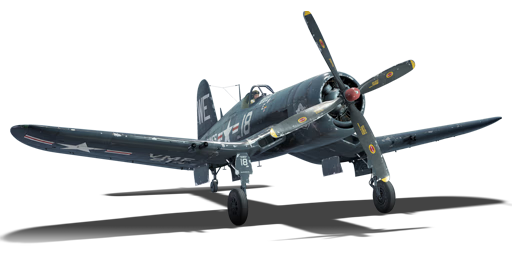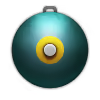


The F4U-4B VMF-214 is based on the Marine Fighter Squadron 214 (VMF-214). Commonly referred to as the "Blacksheep" squadron, their squadron served two combat tours during the Korean War. VMF-214 had eight Corsairs which were transferred from USS Badoeng Strait to USS Sicily. The specific Corsair in-game is based on WE-18, which partook in a raid near Inchon. WE-18, piloted by Lt. Joe Bibby, was forced to crash land after receiving damage from enemy ground forces. Grenades were thrown at the plane to ensure its destruction and marked the final mission for WE-18.
The F4U-4B VMF-214 was introduced as a premium pack for Xbox players in Update 1.79 "Project X". The F4U-4B VMF-214 is much like the regular F4U-4B found in the tech tree. The F4U-4B features four high-velocity 20 mm cannons. Although wing-mounted, they are extremely effective against enemy aircraft and ground targets with the correct belt. Furthermore, they have an ample amount of ammunition so players can be generous with firing the cannons. The F4U-4B also has excellent high-speed and straight-line performance. The enormous Pratt & Whitney R-2800-42w is an improved -38w with a better water injection system, a stronger propeller shaft, and other minor changes. This allows the F4U-4B to reach just under 700 km/h (437 mph) in level flight. The F4U-4B also lacks a conventional airbrake; rather the gears act as the airbrake which is helpful in boom and zoom attacks. Overall, the F4U-4B is an excellent fighter with sufficient suspended ordnance for ground attacks.
flaps
flaps
flaps
brake
| Belt | Belt filling | Armor penetration (mm) at a distance: | |||||
|---|---|---|---|---|---|---|---|
| 10 m | 100 m | 500 m | 1000 m | 1500 m | 2000 m | ||
| HEF-I/AP-T | 36 | 33 | 23 | 15 | 9 | 6 | |
| AP-T/AP-T/HEF-I/HEF-I | 36 | 33 | 23 | 15 | 9 | 6 | |
| HEF-I/HEF-I/HEF-I/AP-T | 36 | 33 | 23 | 15 | 9 | 6 | |
| AP-T/AP-T/AP-T/HEF-I | 36 | 33 | 23 | 15 | 9 | 6 | |
| HEF-I | 5 | 4 | 3 | 2 | 2 | 2 | |
| Belt | Belt filling | Armor penetration (mm) at a distance: | |||||
|---|---|---|---|---|---|---|---|
| 10 m | 100 m | 500 m | 1000 m | 1500 m | 2000 m | ||
| HEF-I/AP-T | 36 | 33 | 23 | 15 | 9 | 6 | |
| AP-T/AP-T/HEF-I/HEF-I | 36 | 33 | 23 | 15 | 9 | 6 | |
| HEF-I/HEF-I/HEF-I/AP-T | 36 | 33 | 23 | 15 | 9 | 6 | |
| AP-T/AP-T/AP-T/HEF-I | 36 | 33 | 23 | 15 | 9 | 6 | |
| HEF-I | 5 | 4 | 3 | 2 | 2 | 2 | |
| Name | Weight | Slot | ||||||||||
|---|---|---|---|---|---|---|---|---|---|---|---|---|
| 62.8 kg |  |  |  |  |  |  |  |  | ||||
| 117.9 kg |  |  |  |  | ||||||||
| 242.6 kg |  |  | ||||||||||
| 500.8 kg |  |  | ||||||||||







 2 x (100 / 230 / 480) %
2 x (100 / 230 / 480) % 
 2 x 172 %
2 x 172 % 

Flight performance | |
|---|---|
Survivability |
|---|
Weaponry | |
|---|---|